Detail
This section explains detailed specification of K2HR3 and description of K2HR3 system configuration. You can refer to Overview and Feature before this section.
USER and TENANT
The K2HR3 system does not manage USER and TENANT, but uses a user management system linked to the K2HR3 system.
For example, if K2HR3 system cooperates with OpenStack, it uses OpenStack users and tenants(or projects) as K2HR3 USER and TENANT.
For user management systems other than OpenStack, prepare additional programs that correspond to individual user management systems, set them in the K2HR3 system, and define them as K2HR3 USER and TENANT.
Cooperating with OpenStack
The figure below shows USER and TENANT defined by the K2HR3 system and the OpenStack which the K2HR3 system cooperates with.
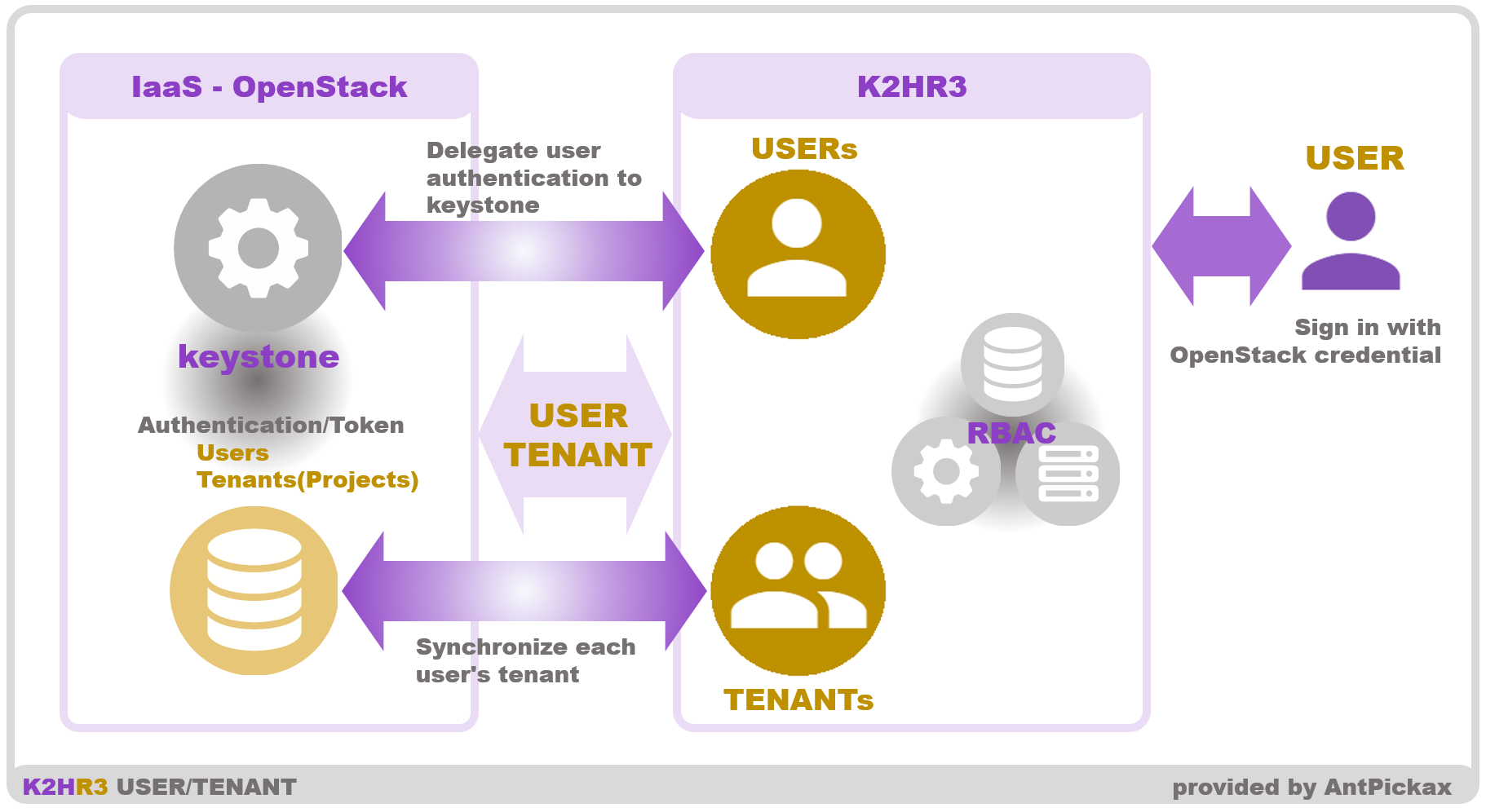
USER and SignIn
The K2HR3 system defines the user of K2HR3 as USER.
USER is the same as the user of IaaS(OpenStack) that the K2HR3 system cooperates with.
By working with OpenStack, the K2HR3 system uses the user who signs in existing OpenStack as USER of K2HR3.
When a user signs in to the K2HR3 system, the K2HR3 system delegates user authentication to the OpenStack Identity service(Keystone).
Therefore, users of the OpenStack Identity service(Keystone) can use the K2HR3 system immediately.
TENANT
TENANT of K2HR3 system is the same as the tenant(or project) of OpenStack that works with the K2HR3 system.
The K2HR3 system operates synchronizing the tenant(or project) information of OpenStack.
Therefore, the USER of the K2HR3 system is automatically linked to TENANT which is the OpenStack tenant(or project) managed by the OpenStack OpenStack Identity service(Keystone).
Authentication system other than OpenStack
If K2HR3 system cooperates with authentication system other than OpenStack, prepare the code to access your user authentication system and configure it into the K2HR3 system.
For kubernetes(when not using OpenStack), refer to this contents.
Preparation
You need to prepare a code to access your user authentication system.
You can see the example code in k2hr3_app/routes/lib/userValidateCredential.js or k2hr3_app/routes/lib/userValidateDebug.js.
Setting
Copy the created dedicated code in the routes/lib directory where you extracted K2HR3 Web Application (k2hr3_app). Next, write this file name(without the extension .js) to ‘validator’ element described in the conf file in the config directory.
Operation
You can log in(sign in) from the K2HR3 Web Application login(Siginin) dialog using the above settings.
This document will be expanded in the future.
ROLE and POLICY-RULE and RESOURCE
The relationship between ROLE, POLICY-RULE and RESOURCE defined by the K2HR3 system is shown in the following figure.
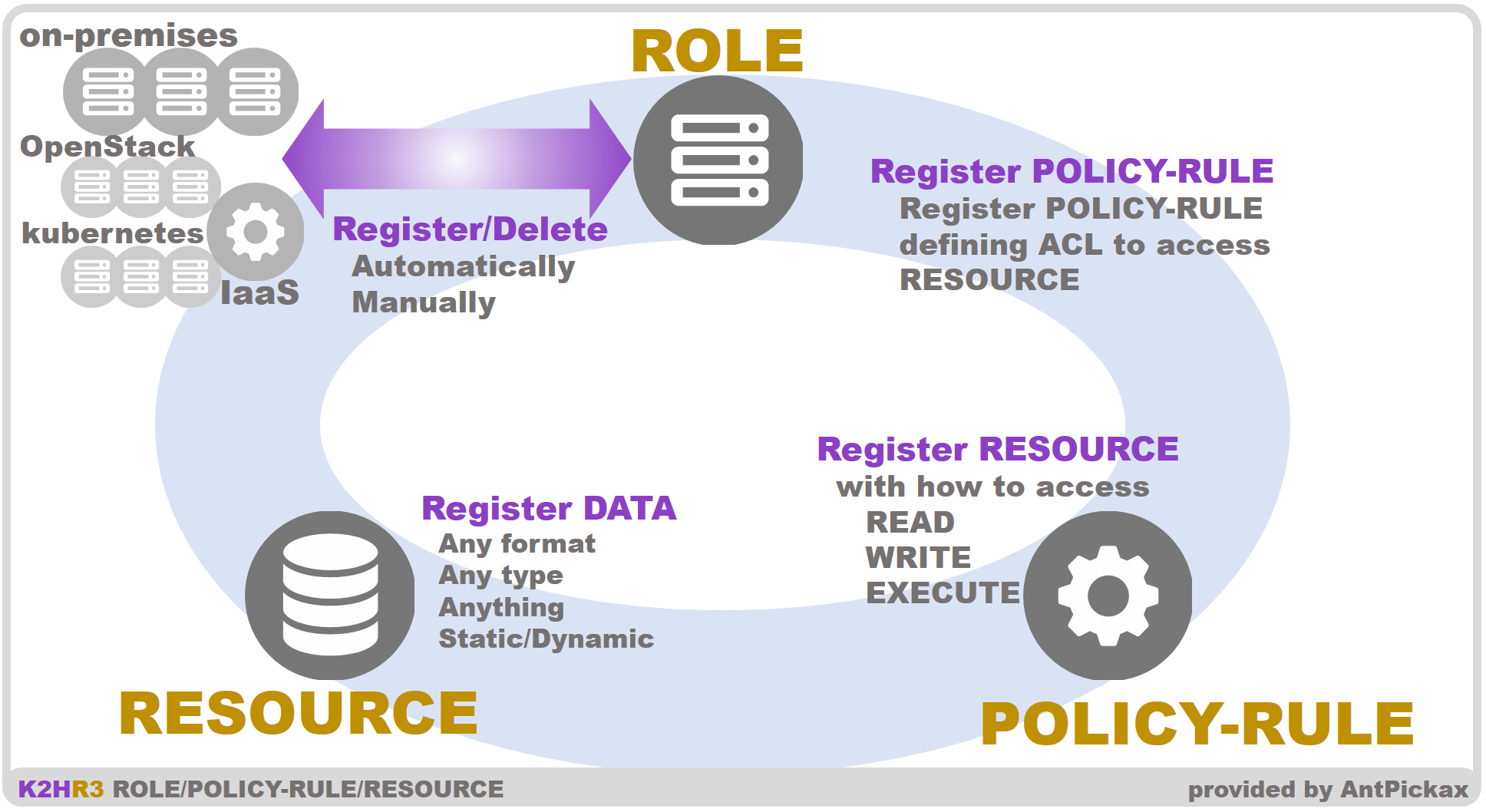
ROLE
ROLE of the K2HR3 system is a group that accesses RESOURCE.
USER defines and registers ROLE for each type of access to RESOURCE and for each group.
ROLE is associated with TENANT to which USER belongs, and is managed separately by TENANT.
ROLE is a definition of a group, and it is data for managing members accessing RESOURCE.
This ROLE member is a host(HOST) that accesses the K2HR3 system REST API server, and is a host by on-premises and a virtual computing(Virtual Machine) and Podd(Conatiners) managed by IaaS(OpenStack, kubernetes).
The IP address(and etc) information of the host(HOST) is registered as a member of ROLE.
ROLE member registration can be automatically registered in conjunction with launch of OpenStack Virtual Machine or kubernetes Pods(Containers) which the K2HR3 system cooperates with.
The ROLE member’s *HOST is automatically deleted from the ROLE in conjunction with the deletion of Virtual Machine of OpenStack or Pods(Containers) of kubernetes.
In addition, USER can manually register/delete ROLE member’s HOST using the K2HR3 Web Application.
POLICY-RULE
POLICY-RULE of the K2HR3 system defines methods and types of access to RESOURCE.
USER defines and registers POLICY-RULE for accessing to each RESOURCE.
POLICY-RULE is associated with TENANT to which USER belongs, and is managed separately by TENANT.
The K2HR3 system defines the following POLICY-RULE value.
The user combines these values and registers POLICY-RULE.
- READ(readable)
- WRITE(writable)
- EXECUTE(executable) reserved
USER expresses the type of access to the target RESOURCE using the above definition and registers with POLICY-RULE with the target RESOURCE.
The K2HR3 system makes ROLE access RESOURCE using POLICY-RULE which defines the access method to RESOURCE.
RESOURCE
RESOURCE of the K2HR3 system is any type(text, binaries etc) of data that USER can freely define.
RESOURCE is associated with TENANT to which USER belongs and is managed individually by TENANT.
As an example of RESOURCE, USER can register special data(setting, configuration etc) required by an application(program) running on ROLE member’s HOST into RESOURCE.
It can register tokens, certificates etc used by these application(program).
USER can also register RESOURCE as a dynamic data that is a template(TEMPLATE) used by the K2HR3 Template Engine(described next section) provided by the K2HR3 system.
This template(TEMPLATE) data allows you to define dynamically RESOURCE and to provide RESOURCE according to your situation.
TEMPLATE
TEMPLATE is text data describing the data(RESOURCE) which is expanded by the K2HR3 template engine.
The user can quote the other RESOURCE and ROLE registered in the K2HR3 system to TEMPLATE and expand its contents when used.
In addition, you can write simple arithmetic operations and conditional statements in TEMPLATE.
The K2HR3 Template Engine loads and expands this TEMPLATE and creates dynamic RESOURCE.
You can see about this in K2HR3 Template Engine.
Collaboration by +SERVICE
The following figure shows the outline of SERVICE and the +SERVICE function provided by the K2HR3 system.
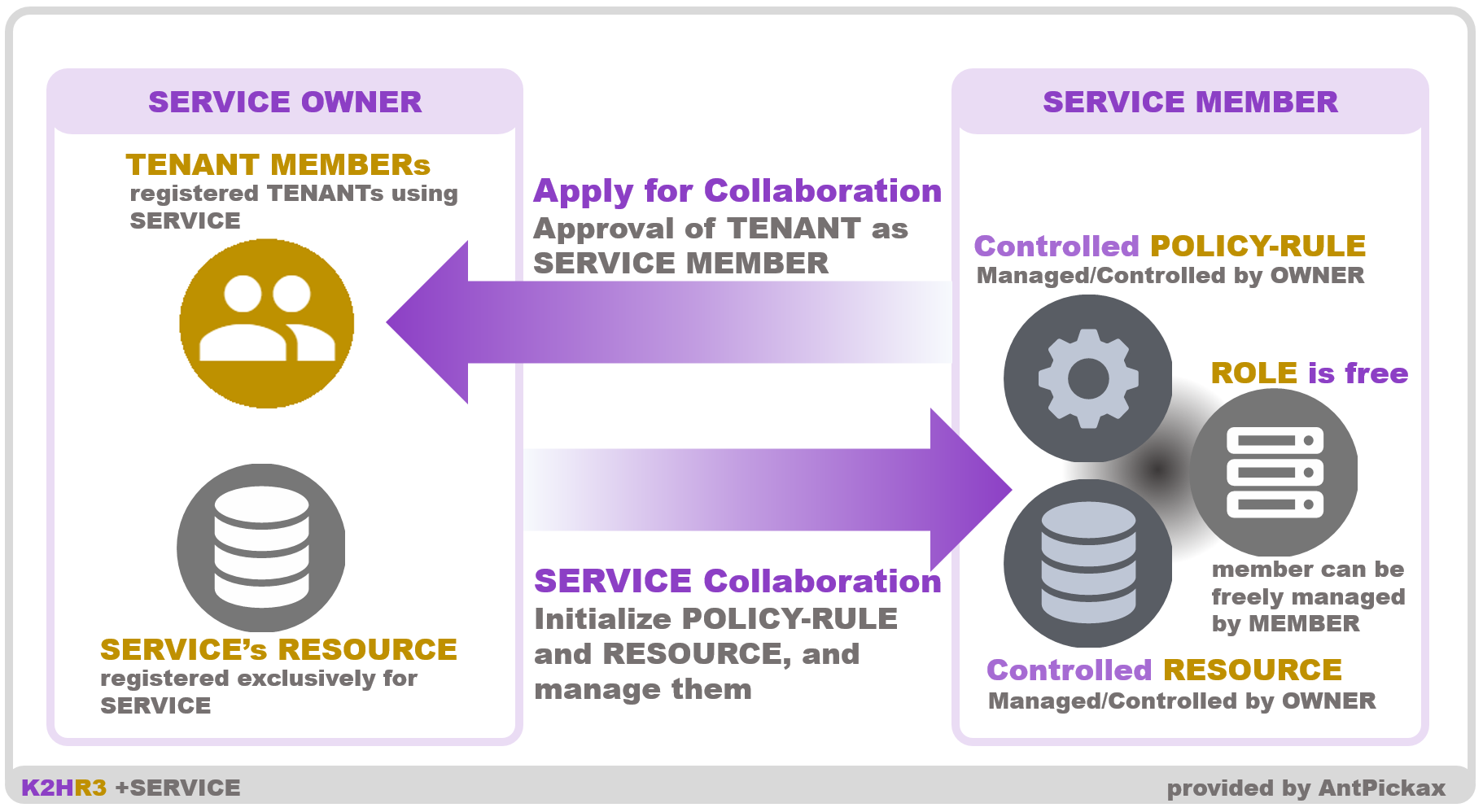
SERVICE
+SERVICE is a function that supports the provision of RESOURCE across different TENANT and ROLE by the K2HR3 system.
SERVICE defined by +SERVICE is data for this function and is data associated with TENANT.
+SERVICE defines system service providers and users as OWNER and MEMBER respectively.
+SERVICE uses SERVICE data to support cooperation between OWNER and MEMBER.
+SERVICE is a word indicating function, and SERVICE is a word indicating data for this +SERVICE function.
Usage
OWNER’s task of RESOURCE is to register TENANT of MEMBER and allow access to RESOURCE.
TENANT of MEMBER permitted to use RESOURCE can freely define ROLE and its members to access the resource RESOURCE.
Therefore, OWNER manages registration of RESOURCE to be provided, control of access method, TENANT of MEMBER.
MEMBER manages the ROLE accessing the provided RESOURCE and manages the HOST of the ROLE member.
Collaboration with IaaS
The K2HR3 system works in cooperation with OpenStack or kubernetes as IaaS(Infrastructure as a Service).
In the case of kubernetes, cooperation with the user authentication system provided to kubernetes is required.
The K2HR3 system links USER and TENANT for K2HR3 system with IaaS.
Matching IaaS users/tenants(or projects) and USER/TENANT makes it easy to introduce the K2HR3 system into existing IaaS systems.
And the K2HR3 system can automatically register/delete ROLE members by working with IaaS.
Automatic registration and deletion of ROLE members will be explained below.
Automatically register to ROLE members
OpenStack
The K2HR3 system automatically adds the instance to the ROLE member as the HOST by starting the OpenStack instance(Virtual Machine).
This automatic registration process is implemented by using User Data Script(USER DATA SCRIPT) specified when OpenStack instance(Virtual Machine) is started up.
This User Data Script is small text data that can be obtained by accessing the K2HR3 Web Application.
USER can acquire User Data Script from K2HR3 Web Application by explicitly specifying the ROLE which USER wants to add instance(HOST) to start.
Pass the acquired User Data Script as a parameter for starting OpenStack instance(Virtual Machine).
kubernetes
In the case of kubernetes, when you start the Pods, specify the Secret setting and Sidecar to Pods and start it.
The yaml example code for Secret and Sidecar can be obtained from the K2HR3 Web Application.
Reflect the obtained yaml sample code to the yaml at the time of startup, and start the Pods.
Automatically delete from ROLE members
OpenStack
The K2HR3 system automatically deletes the instance(HOST) which is deleted by the OpenStack from the ROLE member.
If the target instance(HOST) is created in OpenStack and automatically registered as a member in ROLE, USER can be automatically deleted from the ROLE member by deleting the instance(Virtual Machine) on OpenStack.
This function is implemented by K2HR3 OpenStack Notification Listener.
USER can use this automatic deletion function by starting the K2HR3 OpenStack Notification Listener program provided by K2HR3.
About this program, please refer to K2HR3 OpenStack Notification Listener.
kubernetes
In the case of kubernetes, in the same way as with OpenStack, in conjunction with the deletion of a Pods(Containers), the Pods(Containers) can be automatically deleted from the ROLE member.
If the target Pod(Container) is cooperated by the K2HR3 system and is automatically registered, it is automatically deleted from the member simply by deleting the Pod(Container).
Regular check and removal from ROLE members for OpenStack
Even if USER can not use K2HR3 OpenStack Notification Listener program, USER can automatically delete that host(HOST) from the ROLE member.
For this purpose, USER can launch the Watcher program contained in the K2HR3 system.
The Watcher program regularly checks the existence of the HOST of the ROLE member automatically registered by working with IaaS(OpenStack).
If HOST is deleted and does not exist, the Watcher program automatically deletes that HOST from the ROLE member.
Even if USER can not start K2HR3 OpenStack Notification Listener program, USER can use the equivalent automatic deletion by running this Watcher program.
About this program, please refer to Watcher.
Automatically registration/deletion
OpenStack
The outline diagram of automatic registration and deletion of OpenStack and ROLE members is shown below.
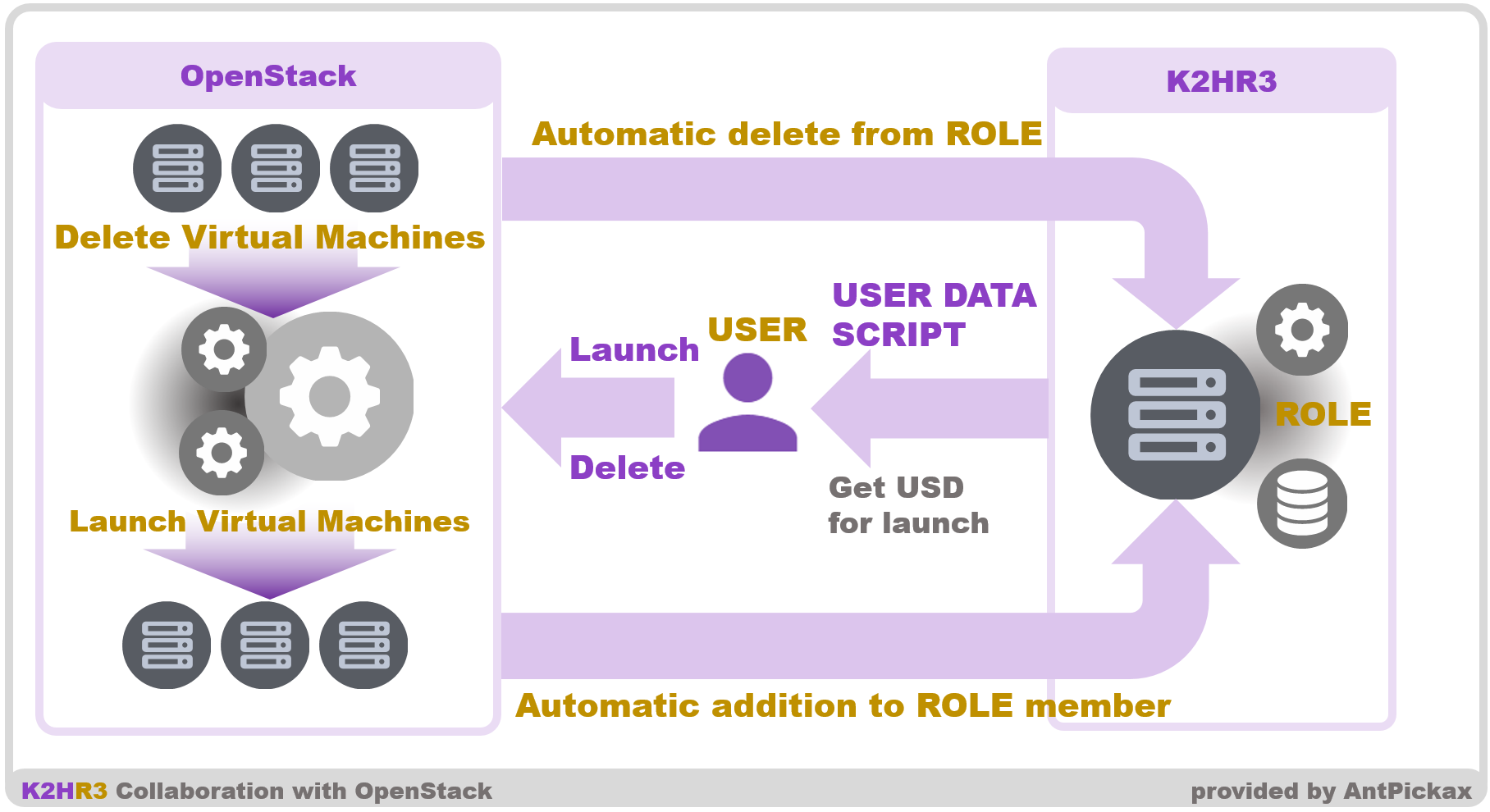
kubernetes
The outline diagram of automatic registration and deletion of kubernetes and ROLE members is shown below.

Other processing at the time of automatic registration/deletion in OpenStack
For OpenStack, specify User Data Script to automatically register/delete ROLE members.
This User Data Script can install packages and start Systemd services during auto-registration.
You can also stop the Systemd service when you remove it.
This setting can be specified in the RESOURCE data.
For more information, see Other Usage.
K2HR3 System Overview
A schematic diagram of the K2HR3 system is shown below.
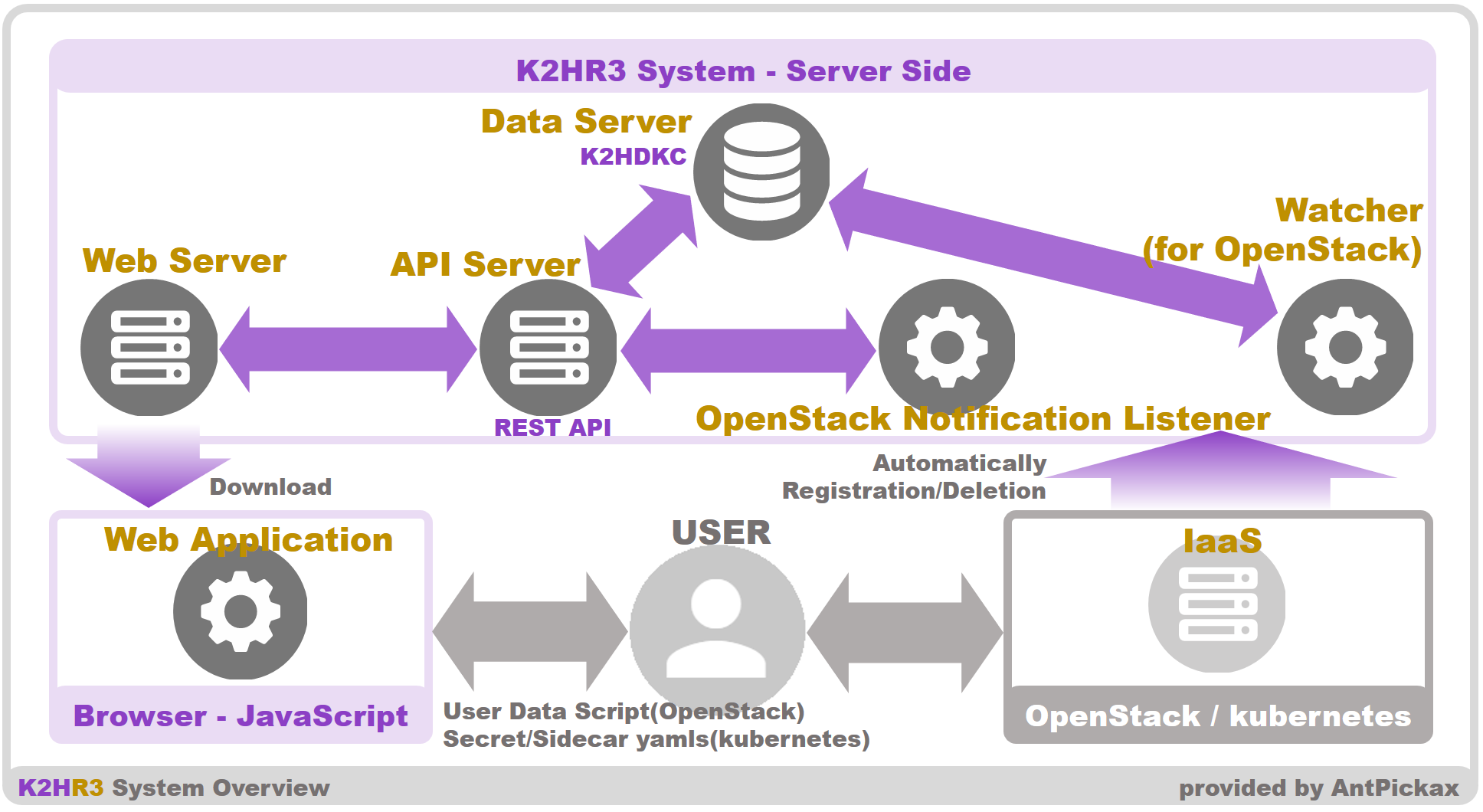
As shown in the figure, the K2HR3 system consists of a Web application, Web server, API server, Data Server(K2HDKC), K2HR3 OpenStack Notification Listener, Watcher subsystem.
Each subsystem is described in the following sections.
K2HR3 Web Application
The Web Application subsystem is accessed from the browser by USER and operates as the control panel of the K2HR3 system.
This is a JavaScript based web application that can manipulate all of the data required by USER.
USER can manipulate ROLE, POLICY-RULE, RESOURCE, SERVICE data using this Web Application.
For details on how to use this subsystem, please see Usage K2HR3 Web Application.
K2HR3 Web Application is created with React.js.
The source code of K2HR3 Web application is in k2hr3_app Github repository, and it is registered as a submodule in k2hr3 Github repository.
K2HR3 Web Server
The Web Server is a server that USER accesses to use the K2HR3 Web Application.
JavaScript of the Web Application is loaded from the Web Server to the browser and executed.
The Web Server is the server side JavaScript program running on Node.js.
The source code of K2HR3 Web Server is in k2hr3_app Github repository, and it is registered as a submodule in k2hr3 Github repository.
K2HR3 API Server
The API Server provides a K2HR3 REST API for manipulating data such as ROLE, POLICY-RULE, RESOURCE, SERVICE stored in the Data Server(K2HDKC).
Using the K2HR3 REST API provided by this API server, the Web Application/Web Server communicates with the Data Server(K2HDKC).
And USER and HOST of the ROLE member directly call this K2HR3 REST API on this API Server, and read/write RESOURCE data.
For details about API Server and REST API, see K2HR3 REST API.
The API Server and K2HR3 REST API is the server side JavaScript program running on Node.js.
The source code of K2HR3 API Server and K2HR3 REST API is in k2hr3_api Github repository, and it is registered as a submodule in k2hr3 Github repository.
K2HR3 Data Server(K2HDKC)
The K2HR3 Data Server(K2HDKC) is a server that stores and manages data such as ROLE, POLICY-RULE, RESOURCE, SERVICE, etc.
This server is constructed with K2HDKC which is distributed KVS provided by AntPickax.
For K2HDKC of distributed KVS, please see K2HDKC.
K2HR3 OpenStack Notification Listener
This server is the server running the K2HR3 OpenStack Notification Listener program.
This program uses OpenStack and automatically deletes target instances(HOST) from ROLE members in conjunction with deletion of instance(HOST) on OpenStack.
For details on how to use this program, please see K2HR3 OpenStack Notification Listener.
The source code of K2HR3 OpenStack Notification Listener is in k2hr3_osnl Github repository, and it is registered as a submodule in k2hr3 Github repository.
K2HR3 Watcher
Watcher is a program that USER uses as an alternative when K2HR3 OpenStack Notification Listener can not be used.
For details on how to use this program, please see Watcher.
The source code of Watcher is in k2hr3_api Github repository, and it is registered as a submodule in k2hr3 Github repository.
K2HR3 Get Resource
K2HR3 Get Resource is a Systemd service that runs on the HOST that accesses the K2HR3 system.
This program is a utility that can periodically acquire RESOURCE data corresponding to the registered ROLE of the HOST.
The source code of K2HR3 Get Resource is in k2hr3_get_resource Github repository, and it is registered as a submodule in k2hr3 Github repository.
K2HR3 Command Line Interface(CLI)
The K2HR3 Command Line Interface(CLI) is a Command Line Interface(CLI) that operates the K2HR3 REST API.
It can run on any HOST that has access to the K2HR3 REST API.
The same operations that users can perform from the K2HR3 Web Application can be performed on the command line.
The source code of K2HR3 Command Line Interface(CLI) is in k2hr3_cli Github repository, and it is registered as a submodule in k2hr3 Github repository.
K2HR3 Helm Chart
K2HR3 Helm Chart is a Helm Chart for building a K2HR3 system using Helm(The package manager for Kubernetes) in a kubernetes environment.
By using this Helm Chart, you can easily build a K2HR3 system in a kubernetes environment.
This can be used to build a K2HR3 system before using the K2HDKC Helm Chart to build a K2HDKC DBaaS in a kubernetes environment.
The source code of K2HR3 Helm Chart is in k2hr3_helm_chart Github repository, and it is published as a repository at Artifact Hub.
RANCHER
K2HR3 Helm Chartは、RANCHERに対応しています。
You can use K2HR3 Helm Chart from RANCHER by registering K2HR3 Helm Chart as a repository in RANCHER.
Various details
Common specifications and other details of the K2HR3 system other than the above are explained in Various Details.
What's new TOP Usage